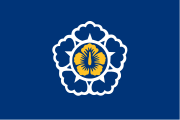Lee Beom-seok (prime minister)
| Lee Beom-seok 이범석 | |
|---|---|
|
| |
| 1st Prime Minister of South Korea | |
|
In office August 1, 1948 – April 21, 1950 | |
| Succeeded by | Shin Sung-mo (acting) |
| Personal details | |
| Born |
October 20, 1900 Hwangseong, Korean Empire (now Seoul, South Korea) |
| Died |
May 11, 1972 (aged 71) Seoul, South Korea |
| Spouse(s) | Kim Maria |
| Military service | |
| Allegiance |
Korean Empire Republic of China South Korea |
| Lee Beom-seok | |
| Hangul | 이범석 |
|---|---|
| Hanja | 李範奭 |
| Revised Romanization | I Beom-seok |
| McCune–Reischauer | Yi Pŏmsŏk |
| Pen name | |
| Hangul | 철기 |
| Hanja | 鐵驥 |
| Revised Romanization | Cheolgi |
| McCune–Reischauer | Ch'ŏlgi |
Lee Beom-seok (1900–1972) was a Korean independence activist and the first prime minister of South Korea from 1948 to 1950.[1] For a time, he also headed the Young Pioneer Corps (조선민족청년단).[2] His nickname was Chulgi.
Biography
Lee Beom-seok was born in Gyeongseong (now Seoul) on October 20th, 1900. Lee's father was an officer of the Joseon Dynasty and he was a descendent of Sejong the Great's son 'Gwangpyeong Daegun (Hangul: 광평대군; Hanja: 廣平大君)'. [3] Lee Beom-seok was exiled to the Republic of China after participating in independence activities as a teenager. In 1919 he started studying at the Shinheung military academy (Hangul: 신흥무관학교; Hanja: 新興武官學校), a military school whose goal was to build a new army to fight for independence. Soon after, Lee fought in the Battle of Cheongsanni, a six-day engagement in eastern Manchuria. He later served as a general in the Korean Liberation Army for the Provisional Government of the Republic of Korea.
In 1945, Lee attempted to return to Korea but was forced to remain in exile in China. In 1946, he returned to Korea and he helped found the Korean National Youth Corps with Ahn Ho-sang.[4] He was opposed to Kim Gu's South-North negotiations (Hangul: 남북협상; Hanja: 南北協商) and allied himself with Lee Syng-man to establish a unitary government in South Korea. He served as the new country's first prime minister from July 31st, 1948 to April 20th, 1950.
Later life and death
Following his term in office, he served as Korean ambassador to the Republic of China and as Secretary of the Interior. He ran for the vice presidency in 1952, and again in 1956, but failed to win either election. Throughout the 1960's he remained a staunch opposition leader to the ruling party. [5]At the end of his career Lee served as an adviser on the Board of National Unification(Hangul: 국토통일원; Hanja: 國土統一院) and mentored Park Chung-hee as a Senator of the nation.
On May the 10th, 1972 he was granted a philosophy doctorate by the Taiwan Chinese Academy. The following day, May 11th, he died of a myocardial infarction in the Seongmo hospital of Myeong-dong in Seoul. His state funeral was held in Square of Namsan Mountain on May 17th. He was buried in Seoul National Cemetery. [6]
Posthumous Work
- Udungbul (Korean: 우둥불)
- Bangrangui Jungyul(Passion of Wandering) (Korean: 방랑의 정열)(Passion of Wandering)
- Hangookui Bunro(Rage of Korea) (Korean: 한국의 분노)
- Bangrangui Jungyul(Passion of Wandering) (Korean: 방랑의 정열)(Passion of Wandering)
- Minjok Gwa Cheongnyun(Nationality and the Young) (Korean: 민족과 청년)
- Hyulgeon: Cheongsanni Ghakgeon(Bloody battle: Strategy of Cheongsanni) (Korean: 혈전: 청산리 작전)
- Tomsk Haneul Arae(Under the Tomsk's Sky) (Korean: 톰스크의 하늘아래)
References
- ↑ Yahu! Baekgwasajeon 야후! 백과사전 [Yahoo! Encyclopedia], s.v. "Lee Beom-seok" 이범석,
- ↑ Carter J. Eckert, Ki-baik Lee, Young Ick Lew, Michael Robinson, and Edward W. Wagner, Korea Old and New: A History (Seoul: Ilchokak / Korea Institute, Harvard University, 1990), 351.
- ↑ "철기 이범석 장군 기념사업회('Chulgi' Lee Beom-seok General's Anniversary) : Lee Beom-Seok(이범석)".
- ↑ "네이버캐스트 : 이범석(Lee Beom-seok)".
- ↑ "인물로 보는 항일무장투쟁사(Armed Resistance against Japanese seeing human) : 역사문제연구소(Research Institute of Historical Problems), 1995, 73p".
- ↑ "혼돈의 해방공간서 자유민주주의의 초석을 놓다(Put the basis of Liberal Democracy in Chaotic place) : 동아일보(Dong-A newspaper), 2008. 08. 22".
Site web
- Lee Beom-seok Memorial museum (Korean)
- Lee Beom-seok (Korean)
| Preceded by N/A |
Prime Minister of South Korea 1948 - 1950 |
Succeeded by Shin Sung-mo (acting) |
| Preceded by N/A |
Defense minister of South Korea 1948 - 1949 |
Succeeded by Shin Sung-mo |
| Preceded by Chnag Seok-yun |
Interior Minister of South Korea 1952 |
Succeeded by Kim Taesun |

